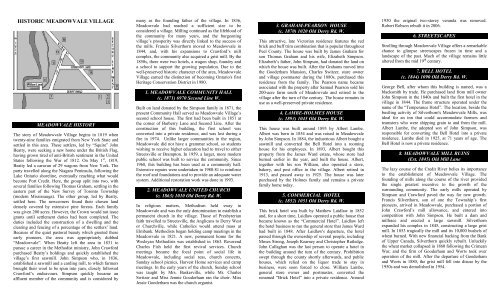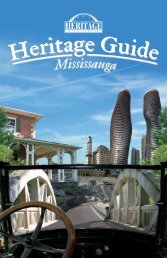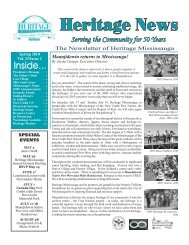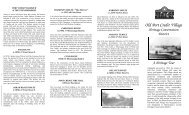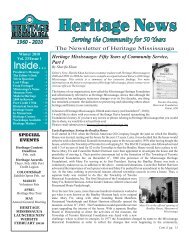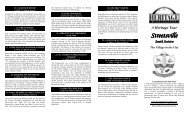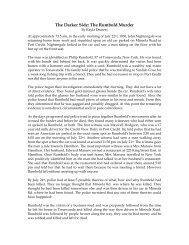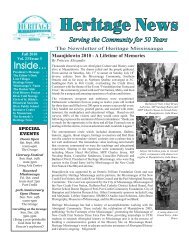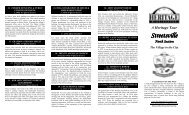Download the Meadowvale Village Heritage Tour Brochure
Download the Meadowvale Village Heritage Tour Brochure
Download the Meadowvale Village Heritage Tour Brochure
You also want an ePaper? Increase the reach of your titles
YUMPU automatically turns print PDFs into web optimized ePapers that Google loves.
HISTORIC MEADOWVALE VILLAGE<br />
MEADOWVALE HISTORY<br />
The story of <strong>Meadowvale</strong> <strong>Village</strong> begins in 1819 when<br />
twenty-nine families emigrated from New York State and<br />
settled in this area. These settlers, led by “Squire” John<br />
Beatty, were seeking a new home under <strong>the</strong> British Flag,<br />
having grown tired of anti-British sentiment in <strong>the</strong> United<br />
States following <strong>the</strong> War of 1812. On May 1 st , 1819,<br />
Beatty led a caravan of 29 wagons from New York. The<br />
party travelled along <strong>the</strong> Niagara Peninsula, following <strong>the</strong><br />
Lake Ontario shoreline, eventually reaching what would<br />
become Port Credit. Here, <strong>the</strong> group split into two, with<br />
several families following Thomas Graham, settling in <strong>the</strong><br />
eastern part of <strong>the</strong> New Survey of Toronto Township<br />
(modern Mississauga). The o<strong>the</strong>r group, led by Beatty,<br />
settled here. The newcomers found <strong>the</strong>ir chosen land<br />
densely covered by extensive pine forests. Each family<br />
was given 200 acres. However, <strong>the</strong> Crown would not issue<br />
grants until settlement duties had been completed. The<br />
duties included <strong>the</strong> construction of a dwelling and <strong>the</strong><br />
clearing and fencing of a percentage of <strong>the</strong> settlers’ land.<br />
Because of <strong>the</strong> quiet pastoral beauty which greeted <strong>the</strong>se<br />
early pioneers, <strong>the</strong> area was appropriately dubbed<br />
“<strong>Meadowvale</strong>”. When Beatty left <strong>the</strong> area in 1831 to<br />
pursue a career in <strong>the</strong> Methodist ministry, John Crawford<br />
purchased Beatty’s holdings and quickly established <strong>the</strong><br />
village’s first sawmill. John Simpson who, in 1836,<br />
established a sawmill and a carding mill, to which farmers<br />
brought <strong>the</strong>ir wool to be spun into yarn, closely followed<br />
Crawford’s endeavours. Simpson quickly became an<br />
affluent member of <strong>the</strong> community and is considered by<br />
many as <strong>the</strong> founding fa<strong>the</strong>r of <strong>the</strong> village. In 1836,<br />
<strong>Meadowvale</strong> had reached a sufficient size to be<br />
considered a village. Milling continued as <strong>the</strong> lifeblood of<br />
<strong>the</strong> community for many years, and <strong>the</strong> burgeoning<br />
village’s prosperity was directly linked to <strong>the</strong> success of<br />
<strong>the</strong> mills. Francis Silverthorn moved to <strong>Meadowvale</strong> in<br />
1844, and, with his expansions to Crawford’s mill<br />
complex, <strong>the</strong> community also acquired a grist mill. By <strong>the</strong><br />
1850s, <strong>the</strong>re were two hotels, a wagon shop, foundry and<br />
a school to support <strong>the</strong> growing population. Due to <strong>the</strong><br />
well-preserved historic character of <strong>the</strong> area, <strong>Meadowvale</strong><br />
<strong>Village</strong> earned <strong>the</strong> distinction of becoming Ontario's first<br />
<strong>Heritage</strong> Conservation District in 1980.<br />
1. MEADOWVALE COMMUNITY HALL<br />
(c. 1871) 6970 Second Line W.<br />
Built on land donated by <strong>the</strong> Simpson family in 1871, <strong>the</strong><br />
present Community Hall served as <strong>Meadowvale</strong> <strong>Village</strong>’s<br />
second school house. The first had been built in 1851 at<br />
<strong>the</strong> corner of Barberry Lane and Second Line. After <strong>the</strong><br />
construction of this building, <strong>the</strong> first school was<br />
converted into a private residence, and was lost during a<br />
fire in 1974. Unlike larger communities in <strong>the</strong> region,<br />
<strong>Meadowvale</strong> did not have a grammar school, so students<br />
wishing to receive higher education had to travel to ei<strong>the</strong>r<br />
Streetsville or Brampton. In 1959, a larger, more modern<br />
public school was built to service <strong>the</strong> community. Since<br />
1968, this building has been used as a community hall.<br />
Extensive repairs were undertaken in 1980-81 to reinforce<br />
<strong>the</strong> roof and foundations and to provide an adequate water<br />
system. Additional restoration work was done in 1993.<br />
2. MEADOWVALE UNITED CHURCH<br />
(c. 1863) 1010 Old Derry Rd. W.<br />
In religious matters, Methodism held sway in<br />
<strong>Meadowvale</strong> and was <strong>the</strong> only denomination to establish a<br />
permanent church in <strong>the</strong> village. Those of Presbyterian<br />
faith travelled to Streetsville, <strong>the</strong> Anglicans to Derry West<br />
or Churchville, while Catholics would attend mass at<br />
Elmbank. Methodists began holding camp meetings in <strong>the</strong><br />
<strong>Meadowvale</strong> in 1821. A new, permanent home for <strong>the</strong><br />
Wesleyan Methodists was established in 1863. Reverend<br />
Charles Fish held <strong>the</strong> first revival services. Church<br />
meetings became <strong>the</strong> focal point of social life in<br />
<strong>Meadowvale</strong>, including social teas, church concerts,<br />
Sunday school picnics, Harvest Home services and camp<br />
meetings. In <strong>the</strong> early years of <strong>the</strong> church, Sunday school<br />
was taught by Mrs. Baskerville, while Mr. Charles<br />
Switzer and Miss Jennie Gooderham ran <strong>the</strong> choir. Miss<br />
Jessie Gooderham was <strong>the</strong> church organist.<br />
3. GRAHAM-PEARSON HOUSE<br />
(c. 1870) 1020 Old Derry Rd. W.<br />
This attractive, late Victorian residence features <strong>the</strong> red<br />
brick and buff trim combination that is popular throughout<br />
Peel County. The house was built by James Graham for<br />
son Thomas Graham and his wife, Elizabeth Simpson.<br />
Elizabeth’s fa<strong>the</strong>r, John Simpson, had donated <strong>the</strong> land on<br />
which <strong>the</strong> house was built. After <strong>the</strong> Grahams moved into<br />
<strong>the</strong> Gooderham Mansion, Charles Switzer, store owner<br />
and village postmaster during <strong>the</strong> 1880s, purchased this<br />
residence from <strong>the</strong> family. The Pearson name became<br />
associated with <strong>the</strong> property after Samuel Pearson sold his<br />
200-acre farm south of <strong>Meadowvale</strong> and retired to <strong>the</strong><br />
village after <strong>the</strong> turn of <strong>the</strong> century. The house remains in<br />
use as a well-preserved private residence.<br />
4. LAMBE-HOLMES HOUSE<br />
(c. 1893) 1045 Old Derry Rd. W.<br />
This house was built around 1893 by Albert Lambe.<br />
Albert was born in 1854 and was raised in <strong>Meadowvale</strong><br />
by John Simpson. In 1884, <strong>the</strong> industrious Albert bought a<br />
sawmill and converted <strong>the</strong> Bell Hotel into a rooming<br />
house for his employees. In 1893, Albert bought this<br />
property from <strong>the</strong> James Ward estate, whose store had<br />
burned earlier in <strong>the</strong> year, and built <strong>the</strong> house. Albert,<br />
toge<strong>the</strong>r with his son William, also operated a store,<br />
bakery, and post office in <strong>the</strong> village. Albert retired in<br />
1913, and passed away in 1925. The house was later<br />
purchased by <strong>the</strong> Holmes family and remains a private<br />
family home today.<br />
5. COMMERCIAL HOTEL<br />
(c. 1852) 1051 Old Derry Rd. W.<br />
This brick hotel was built by Mat<strong>the</strong>w Laidlaw in 1852<br />
and, for a short time, Laidlaw operated a public house that<br />
became known as <strong>the</strong> “Commercial Hotel”. Laidlaw left<br />
<strong>the</strong> hotel business to run <strong>the</strong> general store that James Ward<br />
had built in 1848. After Laidlaw's departure, <strong>the</strong> hotel<br />
passed through <strong>the</strong> ownership of several people, including<br />
Moses Strong, Joseph Kearney and Christopher Rutledge.<br />
John Callaghan was <strong>the</strong> last person to operate a hotel in<br />
<strong>the</strong> building around <strong>the</strong> turn of <strong>the</strong> century. Prohibition<br />
swept through <strong>the</strong> county shortly afterwards, and public<br />
houses, which relied on <strong>the</strong> liquor trade to stay in<br />
business, were soon forced to close. William Lambe,<br />
general store owner and postmaster, converted <strong>the</strong><br />
renamed “Brick Hotel” into a private residence. Around<br />
1950 <strong>the</strong> original two-storey veranda was removed.<br />
Robert Robson rebuilt it in 2006.<br />
6. STREETSCAPES<br />
Strolling through <strong>Meadowvale</strong> <strong>Village</strong> offers a remarkable<br />
chance to glimpse streetscapes frozen in time and a<br />
landscape of <strong>the</strong> past. Much of <strong>the</strong> village remains little<br />
altered from <strong>the</strong> mid 19 th century.<br />
7. BELL HOTEL<br />
(c. 1844) 1090 Old Derry Rd. W.<br />
George Bell, after whom this building is named, was a<br />
blacksmith by trade. He purchased land from mill owner<br />
John Simpson in <strong>the</strong> 1840s and built <strong>the</strong> first hotel in <strong>the</strong><br />
village in 1844. The frame structure operated under <strong>the</strong><br />
name of <strong>the</strong> “Temperance Hotel”. The location, beside <strong>the</strong><br />
bustling activity of Silverthorn's <strong>Meadowvale</strong> Mills, was<br />
ideal for an inn that could accommodate farmers and<br />
teamsters who were shipping grain to and from <strong>the</strong> mill.<br />
Albert Lambe, <strong>the</strong> adopted son of John Simpson, was<br />
responsible for converting <strong>the</strong> Bell Hotel into a private<br />
residence. Lambe died in 1925, at 71 years of age. The<br />
Bell Hotel is now a private residence.<br />
8. MEADOWVALE MILL RUINS<br />
(Est. 1845) Old Mill Lane<br />
The lazy course of <strong>the</strong> Credit River belies its importance<br />
to <strong>the</strong> establishment of <strong>Meadowvale</strong> <strong>Village</strong>. The<br />
founding of mills along <strong>the</strong> course of <strong>the</strong> river provided<br />
<strong>the</strong> single greatest incentive to <strong>the</strong> growth of <strong>the</strong><br />
surrounding community. The early mills operated by<br />
Simpson and Crawford paved <strong>the</strong> way for new growth.<br />
Francis Silverthorn, son of one <strong>the</strong> Township’s first<br />
pioneers, arrived in <strong>Meadowvale</strong>, purchased a portion of<br />
John Crawford’s mill allowance, and entered into<br />
competition with John Simpson. He built a dam and<br />
millrace and erected a large sawmill. Silverthorn<br />
expanded his complex in 1845, constructing a large grist<br />
mill. In 1853 tragically <strong>the</strong> mill and its 10,000 bushels of<br />
wheat burned. With new financial backing from <strong>the</strong> Bank<br />
of Upper Canada, Silverthorn quickly rebuilt. Unluckily<br />
<strong>the</strong> wheat market collapsed in 1860 following <strong>the</strong> Crimean<br />
War, and <strong>the</strong> firm of Gooderham and Worts took over<br />
operation of <strong>the</strong> mill. After <strong>the</strong> departure of Gooderham<br />
and Worts in 1880, <strong>the</strong> grist mill fell into disuse by <strong>the</strong><br />
1950s and was demolished in 1954.


